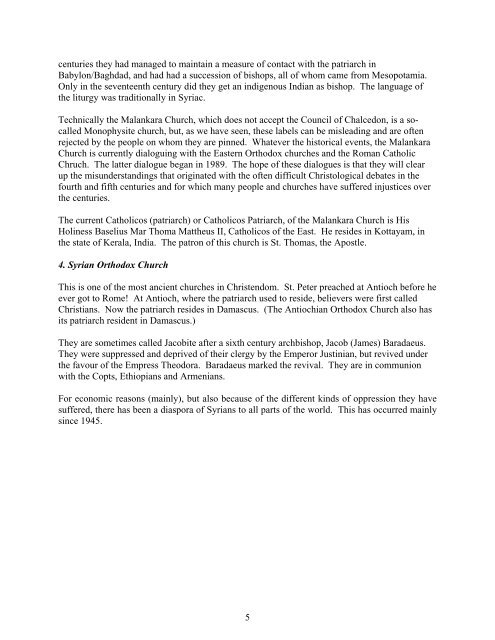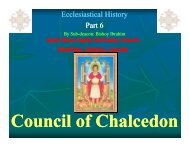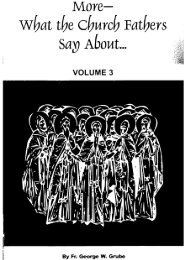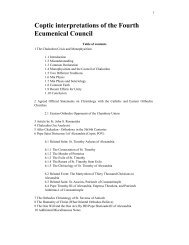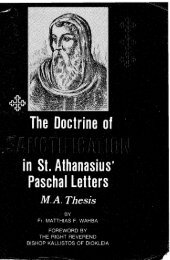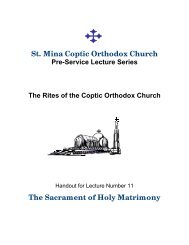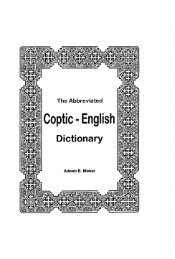- Page 1 and 2: THE COPTIC ORTHODOX CHURCH AND THE
- Page 3: DEDICATION This book is dedicated t
- Page 9 and 10: VI SYNDESMOS Statement; May 1991...
- Page 11 and 12: FOREWORD vi By H.H. Pope Shenouda I
- Page 13 and 14: THE ONE CHURCH CHAPTER 1 UNITY AND
- Page 15: phrase: “One nature of God the Wo
- Page 19 and 20: Later doctrinal and papal developme
- Page 21 and 22: Byzantine Tradition There are nine
- Page 23 and 24: maintain a degree of flexibility in
- Page 25 and 26: CHAPTER 2 THE ECUMENICAL VISION Der
- Page 27 and 28: 5. Youth Ecumenical Committee Under
- Page 29 and 30: Since the beginning the Church used
- Page 31 and 32: etween the two traditions of Orthod
- Page 33 and 34: THE UNOFFICIAL CONSULTATIONS Throug
- Page 35 and 36: Participants Eastern Orthodox Orien
- Page 37 and 38: does not appear therefore to be inc
- Page 39 and 40: THE THIRD UNOFFICIAL CONSULTATION G
- Page 41 and 42: the nature of the Church be safe gu
- Page 43 and 44: (h) To explore the possibilities of
- Page 46 and 47: THE FOURTH UNOFFICIAL CONSULTATION
- Page 48 and 49: Participants Eastern Orthodox Orien
- Page 50 and 51: more clarity of thought and more ea
- Page 52 and 53: THE OFFICIAL CONSULTATIONS After tw
- Page 54 and 55: MEETING OF THE JOINT SUB-COMMITTEE
- Page 56 and 57: JOINT COMMISSION OF THE THEOLOGICAL
- Page 58 and 59: (atreptos), without separation (ach
- Page 60 and 61: REPORT OF THE JOINT SUB-COMMITTEE A
- Page 62 and 63: 1 - In the area of the relation bet
- Page 64 and 65: JOINT-COMMISSION OF THE THEOLOGICAL
- Page 66 and 67:
4. Both families agree that the nat
- Page 68 and 69:
Participants Eastern Orthodox Orien
- Page 70 and 71:
RECOMMENDATIONS ON PASTORAL ISSUES
- Page 72 and 73:
e) Abortion. 12.A joint consultatio
- Page 74 and 75:
Joint Commission Of The Theological
- Page 76 and 77:
iii) A Liturgical Sub-Committee sho
- Page 78 and 79:
POPE SHENOUDA III’S ADDRESS TO PO
- Page 80 and 81:
HOMILY OF POPE PAUL VI May 6th, 197
- Page 82 and 83:
From this new knowledge of God foll
- Page 84 and 85:
conscious of its duty of witnessing
- Page 86 and 87:
RESPONSE OF POPE PAUL VI TO POPE SH
- Page 88 and 89:
POPE PAUL VI’S ADDRESS BEFORE THE
- Page 90 and 91:
We shall always keep in our memory
- Page 92 and 93:
COMMON DECLARATION SIGNED BY POPE P
- Page 94 and 95:
THE INTERNATIONAL JOINT COMMISSION
- Page 96 and 97:
esurrection and ascension. It is fr
- Page 98 and 99:
pastoral activities and exert a mor
- Page 100 and 101:
Participants in the meeting were: C
- Page 102 and 103:
some other bishop. The universal Ch
- Page 104 and 105:
THIRD MEETING OF THE INTERNATIONAL
- Page 106 and 107:
1. The authorities of the Catholic
- Page 108 and 109:
His Divinity. This explains the mos
- Page 110 and 111:
Excellency, Msgr. Youhanna Kabes au
- Page 112 and 113:
A) The Holy See of Rome a) Consider
- Page 114 and 115:
of the theological, ecclesiastical
- Page 116 and 117:
DIRECTIONS TO THE WORK OF THE I.J.C
- Page 118 and 119:
ADDRESS OF POPE JOHN PAUL II TO A C
- Page 120 and 121:
PRINCIPLES FOR GUIDING THE SEARCH F
- Page 122 and 123:
Frequent contacts at all levels of
- Page 124 and 125:
THE RESUMPTION OF THE DIALOGUE When
- Page 126 and 127:
We must bear witness to this common
- Page 128 and 129:
Members Of The Commission Coptic Or
- Page 130 and 131:
SIXTH MEETING OF THE INTERNATIONAL
- Page 132 and 133:
MEETING OF THE POPE OF ALEXANDRIA A
- Page 134 and 135:
PRO ORIENTE ORIENTAL ORTHODOX - CAT
- Page 136 and 137:
The Second Consultation At the seco
- Page 138 and 139:
and the Ecumenical Councils, as the
- Page 140 and 141:
church in truth and love, in Euchar
- Page 142 and 143:
The Fourth Consultation The fourth
- Page 144 and 145:
statements of the See of Rome canno
- Page 146 and 147:
The conversations were held in a co
- Page 148 and 149:
a). Look more closely into the agre
- Page 150 and 151:
she does not on her own respect the
- Page 152 and 153:
4. This communion is participation
- Page 154 and 155:
On each place where the Eucharist i
- Page 156 and 157:
church should not be undertaken wit
- Page 158 and 159:
exchanged by His Eminence and the c
- Page 160 and 161:
7. Confirmation and reception of ec
- Page 162 and 163:
ANGLICAN - COPTIC JOINT DECLARATION
- Page 164 and 165:
THE LAMBETH CONFERENCE The ten year
- Page 166 and 167:
gave birth to the Logos, helped to
- Page 168 and 169:
the patriarch of Constantinople. Wo
- Page 170 and 171:
All Scripture is given by inspirati
- Page 172 and 173:
• Regional Forums The Forum welco
- Page 174 and 175:
CHAPTER 6 COPTIC ORTHODOX AND WORLD
- Page 176 and 177:
4. Dr. Silke-Petra Bergjan presente
- Page 178 and 179:
Possible Topics for Future Discussi
- Page 180 and 181:
ORIENTAL ORTHODOX - REFORMED DIALOG
- Page 182 and 183:
• How do our historical contexts
- Page 184 and 185:
We submit this statement to the aut
- Page 186 and 187:
ORIENTAL ORTHODOX - REFORMED DIALOG
- Page 188 and 189:
• In their understanding, Scriptu
- Page 190 and 191:
• Theologia reformata et semper r
- Page 192 and 193:
Participants in the Third Session O
- Page 194 and 195:
Participants in the Fourth Session
- Page 196 and 197:
CHAPTER 8 COPTIC ORTHODOX AND PRESB
- Page 198 and 199:
CHAPTER 9 CONSTRUCTING BRIDGES OF L
- Page 200 and 201:
PRELIMINARY MEETING OF ORIENTAL ORT
- Page 202 and 203:
(ie. In the Apostolic Faith) in the
- Page 204 and 205:
THE SECOND MEETING OF THE HEADS OF
- Page 206 and 207:
Fourth: The Middle East Council of
- Page 208 and 209:
THE THIRD MEETING OF THE HEADS OF T
- Page 210 and 211:
Oriental Orthodox family will join
- Page 212 and 213:
THE FOURTH MEETING OF THE HEADS OF
- Page 214 and 215:
that this document become a matter
- Page 216 and 217:
these will widen the circle of viol
- Page 218 and 219:
and demand of our faith and by the
- Page 220 and 221:
CHAPTER 10 ECUMENICAL ORGANISATIONS
- Page 222 and 223:
WORLD COUNCIL OF CHURCHES Founded i
- Page 224 and 225:
In 1961 the assembly was held in Ne
- Page 226 and 227:
i The Trinitarian God, ii Salvation
- Page 228 and 229:
Special Commission on Orthodox Part
- Page 230 and 231:
ALL AFRICA CONFERENCE OF CHURCHES A
- Page 232 and 233:
THE ALEXANDRIAN CONFESSION (1976) T
- Page 234 and 235:
THE MECC LOGO The logo of the Middl
- Page 236 and 237:
Conducted every 5 years, the assemb
- Page 238 and 239:
our skill in reading the writing th
- Page 240 and 241:
Patriarch of Jerusalem for the Gree
- Page 242 and 243:
SYNDESMOS It is the World Fellowshi
- Page 244 and 245:
APPENDIX I CHRISTOLOGICAL AGREEMENT
- Page 246 and 247:
APPENDIX II ADDRESS BY H.H. POPE SH
- Page 248 and 249:
St. John the divine, a pillar of th
- Page 250 and 251:
CHURCH UNITY IS AN HISTORICAL INHER
- Page 252 and 253:
“We all believe that Our Lord, Go
- Page 254 and 255:
An excursion was organised to visit
- Page 256 and 257:
You will understand, therefore, tha
- Page 258 and 259:
tradition of our Church, is changed
- Page 260 and 261:
feeling in themselves the pain of d
- Page 262 and 263:
The Coptic Orthodox have been assur
- Page 264 and 265:
APPENDIX IX LETTER OF HIS HOLINESS
- Page 266 and 267:
APPENDIX X TELEGRAM FROM H.H POPE J
- Page 268 and 269:
eport that only a few priests have
- Page 270 and 271:
Bibliography Arruda, M. (ed.), Ecum


